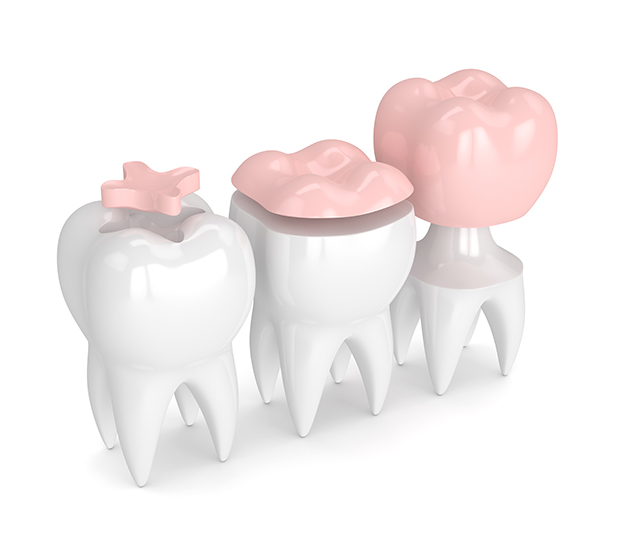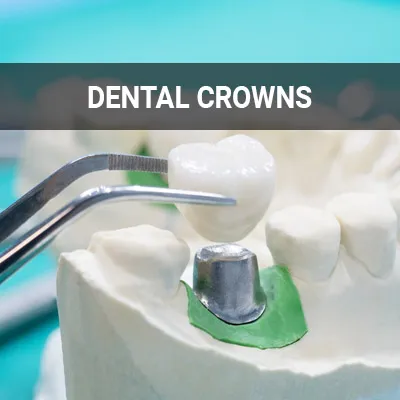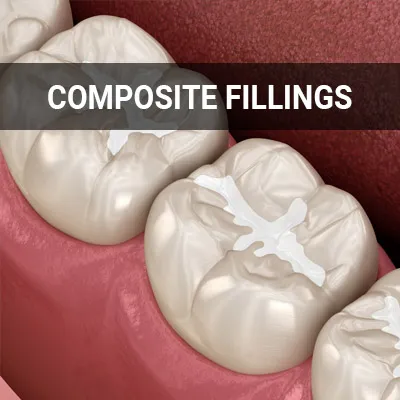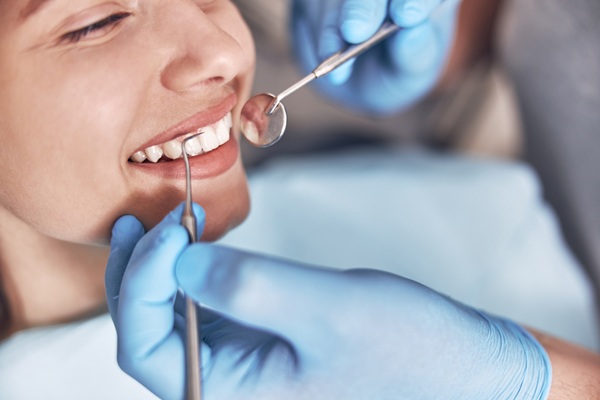Dental Inlays and Onlays Marietta, GA
Dental crowns and fillings are pretty common procedures used to fill in cavities and decay. However, there are alternatives out there. Dental inlays and onlays can also be used. They are stronger than a filling, but not as invasive as a crown, which may involve having to reshape the tooth.
It is helpful to think of inlays and onlays as the middle ground between fillings and a crown. Dental inlays and onlays are available at Happy Dental and Orthodontics in Marietta and the surrounding area. Call us at (770) 200-4034 to schedule an appointment to learn if this treatment option could work for you.
Inlays and Onlays Explained
An inlay is a molded and fitted filling used to treat minor tooth decay, fracture, or other dental damage. It is most often used to restore a tooth that has a cavity that does not extend past the center. They are created using an imprint of the affected area.
Getting a dental inlay fitted onto your tooth is relatively simple. Once the area has been cleaned of decay, an impression will be taken and sent out for manufacturing. The inlay will be made out of tooth-colored porcelain or composite resin material. It is then bonded to your tooth.
Onlays also fit inside the tooth but can extend further over the tooth than an inlay. They are also called partial crowns. Dentists choose this option when a cavity is too big for a standard filling, or the tooth is at risk for cracking. An onlay will strengthen the tooth along with protecting the decaying area.
The dentist prepares the tooth similar to a filling. A temporary onlay is placed over the cavity and an impression is sent out to make the permanent onlay out of porcelain or composite material. With an onlay, more of the tooth's structure is preserved.
Inlays and onlays are typically made of similar, tooth-colored materials. While they both are used to fill in areas of decay, an onlay can work for a larger area, including the cusps, or edges, of the tooth. Compared to traditional fillings, inlays and onlays can increase tooth strength.
“Inlays and onlays are typically made of similar, tooth-colored materials.”
Inlay vs. Filling
Similar to the onlay and crown comparison, there are several things to keep in mind when looking at inlays versus fillings. Traditional fillings are typically recommended for minor cavities, while inlays can be used to fill larger cavities that are not severe enough to need a crown. While inlays are more durable than fillings, fillings can be placed much more quickly. An inlay takes at least two visits - one for the impression to be made and one for the placement.
“Similar to the onlay and crown comparison, there are several things to keep in mind when looking at inlays versus fillings.”
Onlay vs. Crown
Compared to a crown, an onlay is a less aggressive type of restoration and allows for more of your tooth's structure to be preserved. If your tooth is relatively intact but requires some of the edges to be replaced, an onlay is a good choice. If your tooth has extensive damage or decay, you will likely need a crown. Our dentist will evaluate your situation and recommended which treatment option would be best.
“Compared to a crown, an onlay is a less aggressive type of restoration and allows for more of your tooth’s structure to be preserved.”
Check out what others are saying about our dental services on Yelp: Dental Inlays and Onlays in Marietta, GA
Benefits of Inlays and Onlays
With any tooth restoration procedure, the goal is to save as much of your original tooth as possible. Inlays and onlays allow the dentist to preserve more of your natural tooth structure. This not only makes cleaning your teeth easier but is also better for your long-term oral health.
Inlays and onlays are also durable and long-lasting. Inlays can last as long as 30 years when taken care of properly. They are also designed to blend with your natural tooth color.
“With any tooth restoration procedure, the goal is to save as much of your original tooth as possible.”
Questions Answered on This Page
Q. Can you explain inlays and onlays?
Q. What is the difference inlay vs. filling?
Q. What is the difference onlay vs. crown?
Q. What are the benefits of inlays and onlays?
Q. What is the difference between inlays, onlays, and veneers?
People Also Ask
Q. What are composite fillings?
Q. What lifestyle choices help promote good oral health?
Inlays, Onlays, and Veneers
While they may seem similar, veneers, inlays, and onlays are not the same. Onlays and inlays are used to fill and protect damage to the chewing service of the tooth, while veneers are used to cover the front of the tooth in areas that show when you smile. Veneers are not typically used to address tooth decay and are used for more cosmetic reasons.
A veneer is a great option for people who want to correct cosmetic flaws or treat a stained tooth, chipped, or crooked. However, veneers do not provide the structural support or protection of an inlay or onlay. To properly address decay or other damage, an inlay or onlay is the preferred choice.
“While they may seem similar, veneers, inlays, and onlays are not the same.”
Frequently Asked Questions about Inlays and Onlays
Q. Does my insurance cover inlays and onlays?
A. Dental insurance coverage varies from person to person. You will want to reach out to your insurance provider directly to find out if they cover inlays and onlays. Our staff will help you determine any out-of-pocket costs.
Q. What is the difference between inlays and onlays?
A. An inlay is meant to fit in the center of a back tooth and covers only a portion of the chewing surface. An onlay will cover more of the tooth, such as the small points or ridges along the sides. Both inlays and onlays are made from impressions of the area so they are a perfect fit.
Q. Can I get an inlay or onlay in one visit?
A. Since inlays and onlays are made off-site, they require two office visits to be put into place. Once the decay and damaged material are removed, our dentist will make an impression of the site to be filled. A temporary covering will protect your tooth between visits.
Q. What can I expect after getting an inlay or onlay?
A. After the procedure, there is usually a little discomfort, but most patients can adapt to the new chewing surface quickly. Sometimes the tissues around the area worked on are sore or the tooth is sensitive to hot and cold. These issues should fix themselves in one or two days.
Dental Terminology
Learn More About Inlays and Onlays Today
If you are considering replacing your old fillings and crowns or want to schedule a consultation appointment, call us at 770-200-4034 to speak to Happy Dental and Orthodontics. By taking full-mouth X-rays, a custom treatment plan will help to meet your needs.
Helpful Related Links
- American Dental Association (ADA). Glossary of Dental Clinical Terms. 2024
- American Academy of Cosmetic Dentistry® (AACD). Home Page. 2024
- WebMD. WebMD’s Oral Care Guide. 2024
About our business and website security
- Happy Dental and Orthodontics was established in 2021.
- We accept the following payment methods: American Express, Cash, Discover, MasterCard, and Visa
- We serve patients from the following counties: Cobb County and Fulton County
- We serve patients from the following cities: Marietta, Smyrna, Sandy Springs, Atlanta, Kennesaw, Roswell, Acworth, East Cobb, Alpharetta and Fair Oaks
- National Provider Identifier Database (1407403652). View NPI Registry Information
- Norton Safe Web. View Details
- Trend Micro Site Safety Center. View Details
Back to top of Dental Inlays and Onlays










